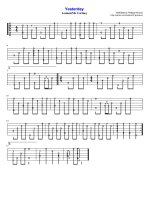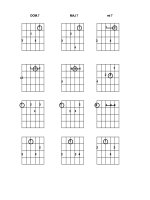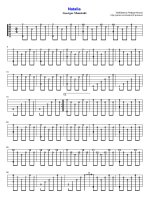Session 06 XP tủ tài liệu bách khoa
Bạn đang xem bản rút gọn của tài liệu. Xem và tải ngay bản đầy đủ của tài liệu tại đây (2.46 MB, 61 trang )
Fundamentals of Java
Explain the process of creation of classes in Java
Explain the instantiation of objects in Java
Explain the purpose of instance variables and instance
methods
Explain constructors in Java
Explain the memory management in Java
Explain object initializers
© Aptech Ltd.
Classes and Objects/Session 6
2
Class in Java:
Is the prime unit of execution for object-oriented programming in Java.
Is a logical structure that defines the shape and nature of an object.
Is defined as a new data type that is used to create objects of its type.
Defines attributes referred to as fields that represents the state of an
object.
Conventions to be followed while naming a class
• Class declaration should begin with the keyword class followed by
the name of the class.
• Class name should be a noun.
• Class name can be in mixed case, with the first letter of each
internal word capitalized.
• Class name should be simple, descriptive, and meaningful.
• Class name cannot be Java keywords.
• Class name cannot begin with a digit. However, they can begin with
a dollar ($) symbol or an underscore character.
© Aptech Ltd.
Classes and Objects/Session 6
3
The syntax to declare a class in Java is as follows:
Syntax
class <class_name> {
// class body
}
The body of the class is enclosed between the curly braces {}.
In the class body, you can declare members, such as fields, methods, and constructors.
Following figure shows the declaration of a sample class:
© Aptech Ltd.
Classes and Objects/Session 6
4
Following code snippet shows the code for declaring a class
Customer:
class Customer {
// body of class
}
In the code:
A class is declared that acts as a new data type with the name
Customer.
It is just a template for creating multiple objects with similar features.
It does not occupy any memory.
Creating Objects:
© Aptech Ltd.
Objects are the actual instances of the class.
Classes and Objects/Session 6
5
An object is created using the new operator.
On encountering the new operator:
JVM allocates memory for the object.
Returns a reference or memory address of the allocated object.
The reference or memory address is then stored in a variable called as
reference variable.
The syntax for creating an object is as follows:
Syntax
<class_name> <object_name> = new <class_name> ();
where,
new: Is an operator that allocates the memory for an object at runtime.
object_name: Is the variable that stores the reference of the object.
© Aptech Ltd.
Classes and Objects/Session 6
6
Following code snippet demonstrates the creation of an object in
a Java program:
Customer objCustomer = new Customer();
© Aptech Ltd.
The expression on the right side, new Customer() allocates the
memory at runtime.
After the memory is allocated for the object, it returns the reference or
address of the allocated object, which is stored in the variable,
objCustomer.
Classes and Objects/Session 6
7
Alternatively, an object can be created using two steps that are
as follows:
Declaration of an object reference.
Dynamic memory allocation of an object.
Declaration of an object reference:
The syntax for declaring the object reference is as follows:
Syntax
<class_name> <object_name>;
where,
object_name: Is just a variable that will not point to any
memory location.
© Aptech Ltd.
Classes and Objects/Session 6
8
Following figure shows the effect of the statement, Customer
objCustomer; which declares a reference variable:
By default, the value null is stored in the object’s reference variable which
means reference variable does not point to an actual object.
If objCustomer is used at this point of time, without being instantiated,
then the program will result in a compile time error.
© Aptech Ltd.
Classes and Objects/Session 6
9
Dynamic memory allocation of an object:
The object should be initialized using the new operator which dynamically
allocates memory for an object.
For example, the statement, objCustomer = new Customer();
allocates memory for the object and memory address of the allocated
object is stored in the variable objCustomer.
Following figure shows the creation of object in the memory and
storing of its reference in the variable, objCustomer:
© Aptech Ltd.
Classes and Objects/Session 6
10
The members of a class are fields and methods.
Fields
• Define the state of an object created from the class.
• Referred to as instance variables.
Methods
• Implement the behavior of the objects.
• Referred to as instance methods.
© Aptech Ltd.
Classes and Objects/Session 6
11
They are used to store data in them.
They are called instance variables because each instance of the
class, that is, object of that class will have its own copy of the
instance variables.
They are declared similar to local variables.
They are declared inside a class, but outside any method
definitions.
For example: Consider a scenario where the Customer class
represents the details of customers holding accounts in a bank.
© Aptech Ltd.
A typical question that can be asked is ‘What are the different data that
are required to identify a customer in a banking domain and represent it
as a single object?’.
Classes and Objects/Session 6
12
Following figure shows a Customer object with its data requirement:
The identified data requirements for a bank customer includes: Customer ID,
Name, Address, and Age.
To map these data requirements in a Customer class, instance variables are
declared.
© Aptech Ltd.
Classes and Objects/Session 6
13
Each instance created from the Customer class will have its own copy of the
instance variables.
Following figure shows various instances of the class with their own copy of
instance variables:
© Aptech Ltd.
Classes and Objects/Session 6
14
The syntax to declare an instance variable within a class is as follows:
Syntax
[access_modifier] data_type instanceVariableName;
where,
access_modifier: Is an optional keyword specifying the access level of an
instance variable. It could be private, protected, and public.
data_type: Specifies the data type of the variable.
instanceVariableName: Specifies the name of the variable.
Instance variables are accessed by objects using the dot operator (.).
© Aptech Ltd.
Classes and Objects/Session 6
15
Following code snippet demonstrates the declaration of instance
variables within a class in the Java program:
1: public class Customer {
2:
3:
4:
5:
6:
// Declare instance variables
int customerID;
String customerName;
String customerAddress;
int customerAge;
7: /* As main() method is a member of class, so it can access other
8: * members of the class */
9:
public static void main(String[] args) {
10:
// Declares and instantiates an object of type Customer
11:
Customer objCustomer1 = new Customer();
© Aptech Ltd.
Lines 3 to 6 declares instance variables.
Line 11 creates an object of type Customer and stores its reference in
the variable, objCustomer1.
Classes and Objects/Session 6
16
12:
13:
14:
15:
16:
// Accesses the instance variables to store values
objCustomer1.customerID = 100;
objCustomer1.customerName = “John”;
objCustomer1.customerAddress = “123 Street”;
objCustomer1.customerAge = 30;
17: // Displays the objCustomer1
18: System.out.println(“Customer
objCustomer1.customerID);
19: System.out.println(“Customer
20: System.out.println(“Customer
customerAddress);
21: System.out.println(“Customer
}
}
© Aptech Ltd.
object details
Identification Number: “ +
Name: “ + objCustomer1.customerName);
Address: “ + objCustomer1.
Age: “ + objCustomer1.customerAge);
Lines 13 to 16 accesses the instance variables and assigns them the
values.
Lines 18 to 21 display the values assigned to the instance variables for the
object, objCustomer1.
Classes and Objects/Session 6
17
Following figure shows the allocation of Customer object in the memory:
Following figure shows the output of the code:
© Aptech Ltd.
Classes and Objects/Session 6
18
They are functions declared in a class.
They implement the behavior of an object.
They are used to perform operations on the instance variables.
They can be accessed by instantiating an object of the class in which it is defined and
then, invoking the method.
For example: the class Car can have a method Brake() that represents the ‘Apply
Brake’ action.
To perform the action, the method Brake() will have to be invoked by an object of class
Car.
Conventions to be followed while naming a method are as follows:
• Cannot be a Java keyword.
• Cannot contain spaces.
• Cannot begin with a digit.
• Can begin with a letter, underscore, or a ‘$’ symbol.
• Should be a verb in lowercase.
• Should be descriptive and meaningful.
• Should be a multi-word name that begins with a verb in lowercase,
followed by adjectives, nouns, and so forth.
© Aptech Ltd.
Classes and Objects/Session 6
19
Following figure shows the instance methods declared in the class,
Customer:
© Aptech Ltd.
Classes and Objects/Session 6
20
The syntax to declare an instance method in a class is as follows:
Syntax
[access_modifier] <return type> <method_name> ([list
of parameters]) {
// Body of the method
}
where,
access_modifier: Is an optional keyword specifying the access level of an
instance method. It could be private, protected, and public.
returntype: Specifies the data type of the value that is returned by the
method.
method_name: Is the method name.
list of parameters: Are the values passed to the method.
© Aptech Ltd.
Classes and Objects/Session 6
21
Following figure shows the declaration of an instance method within the class:
Each instance of the class has its own instance variables, but the instance
methods are shared by all the instances of the class during execution.
© Aptech Ltd.
Classes and Objects/Session 6
22
Following code snippet demonstrates the code that declares instance
methods within the class, Customer:
public class Customer {
// Declare instance variables
int customerID;
String customerName;
String customerAddress;
int customerAge;
/**
* Declares an instance method changeCustomerAddress is created to
* change the address of the customer object
*/
void changeCustomerAddress(String address) {
customerAddress = address;
}
The instance methods changeCustomerAddress() method will accept a
string value through parameter address.
It then assigns the value of address variable to the customerAddress
field.
© Aptech Ltd.
Classes and Objects/Session 6
23
/**
* Declares an instance method displayCustomerInformation is created
* to display the details of the customer object
*/
void displayCustomerInformation() {
System.out.println(“Customer Identification Number: “ + customerID);
System.out.println(“Customer Name: “ + customerName);
System.out.println(“Customer Address: “ + customerAddress);
System.out.println(“Customer Age: “ + customerAge);
}
}
The method displayCustomerInformation() displays the details of
the customer object.
© Aptech Ltd.
Classes and Objects/Session 6
24
To invoke a method, the object name is followed by the dot
operator (.) and the method name.
A method is always invoked from another method.
The method which invokes a method is referred to as the calling
method.
The invoked method is referred to as the called method.
After execution of all the statements within the code block of the
invoked method, the control returns back to the calling method.
© Aptech Ltd.
Classes and Objects/Session 6
25









